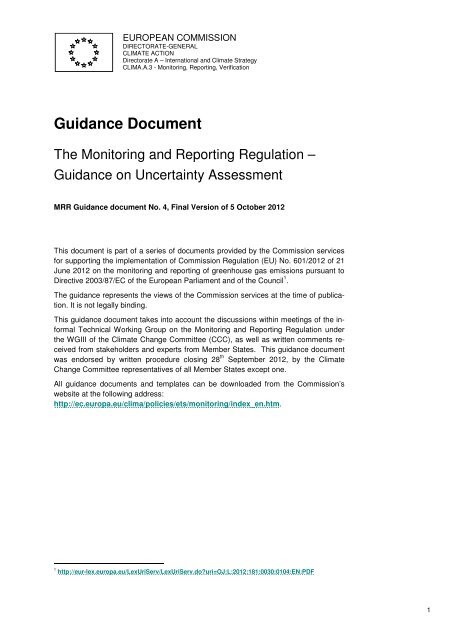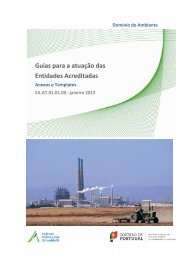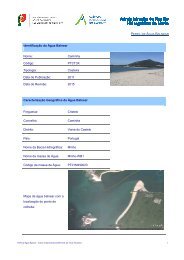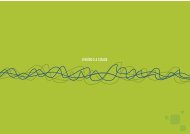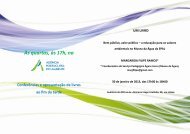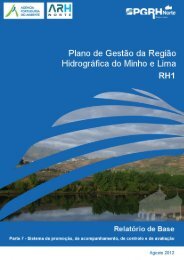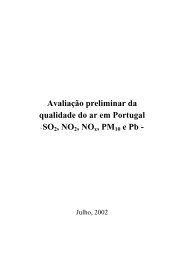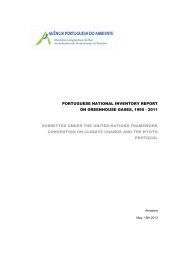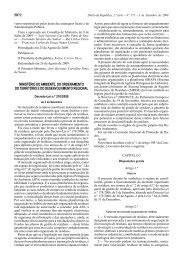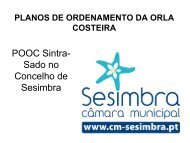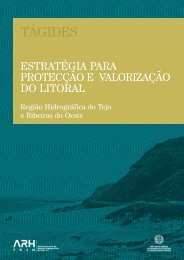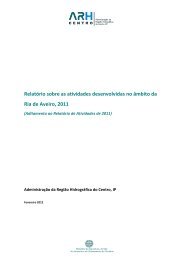Guidance on Uncertainty Assessment - European Commission ...
Guidance on Uncertainty Assessment - European Commission ...
Guidance on Uncertainty Assessment - European Commission ...
You also want an ePaper? Increase the reach of your titles
YUMPU automatically turns print PDFs into web optimized ePapers that Google loves.
Template No. 4: Annual emissi<strong>on</strong>s report of stati<strong>on</strong>ary installati<strong>on</strong>sTemplate No. 5: Annual emissi<strong>on</strong>s report of aircraft operatorsTemplate No. 6: T<strong>on</strong>ne-kilometre data report of aircraft operatorsBesides these documents dedicated to the MRR, a separate set of guidance documents<strong>on</strong> the A&V Regulati<strong>on</strong> is available under the same address.All EU legislati<strong>on</strong> is found <strong>on</strong> EUR-Lex: http://eur-lex.europa.eu/The most important legislati<strong>on</strong> is furthermore listed in the Annex of this document.Also competent authorities in the Member States may provide useful guidance <strong>on</strong> theirown websites. Operators of installati<strong>on</strong>s should in particular check if the competentauthority provides workshops, FAQs, helpdesks etc.5
Choose <strong>on</strong>e or morem<strong>on</strong>itoring approachesCalculati<strong>on</strong>-based(chapter 3)Measurement-based(chapter 4)Fall-back(chapter 5)Activity data (3.1)Operator’s c<strong>on</strong>trol (3.1.1)• Route CO-1/2a/2b/3EN 14181, EN 15259 orother standards<strong>Uncertainty</strong> over the wholeinstallati<strong>on</strong> (also see Annex///, secti<strong>on</strong> 8.4)Not operator’s c<strong>on</strong>trol (3.1.2)• Route CT-1/2Calculati<strong>on</strong> factors (3.2)• “1/3” rule• Reference to GD5 “Sampling& Analysis”Figure 2:Relevant chapters and secti<strong>on</strong>s in this document regarding determinati<strong>on</strong> ofuncertaintyThis document is divided into chapters according to the m<strong>on</strong>itoring approach applied: Calculati<strong>on</strong>-based approaches are discussed in chapter 3; For measurement-based approaches, see chapter 4; Fall-back approaches are described in chapter 5.Due to the availability of various simplificati<strong>on</strong> opti<strong>on</strong>s under the MRR, there are usuallyseveral routes by which an operator can dem<strong>on</strong>strate that the uncertainty levels corresp<strong>on</strong>dingto certain tiers are achieved, as shown in Figure 2. Those opti<strong>on</strong>s (orroutes) are assigned codes throughout this document. For example, if a calculati<strong>on</strong>basedmethodology is applied and the activity data of a source stream are m<strong>on</strong>itoredby a measurement system outside the operator’s own c<strong>on</strong>trol, chapter 3 and secti<strong>on</strong>s3.1 and 3.1.2 (Route CT-1, CT-2 or CT-3) in particular will provide relevant guidancefor assessing uncertainty related to that activity data.9
3 UNCERTAINTY FOR CALCULATION-BASEDAPPROACHESThe following formula shows the calculati<strong>on</strong> of emissi<strong>on</strong>s related to the most comm<strong>on</strong>case, i.e. the combusti<strong>on</strong> of fuels, using the standard calculati<strong>on</strong> method in accordancewith Article 24(1):Example: Calculati<strong>on</strong>-based m<strong>on</strong>itoring of combusti<strong>on</strong>s of fuelsWhere:Em ....... Emissi<strong>on</strong>s [t CO 2 ]Em = AD ⋅ NCV ⋅ EF ⋅OF⋅( 1−BF)AD ....... Activity data (= fuel quantity) [t or Nm 3 ]NCV..... Net Calorific Value [TJ/t or TJ/Nm 3 ]EF ........ Emissi<strong>on</strong> factor [t CO 2 /TJ, t CO 2 /t or t CO 2 /Nm 3 ]OF ....... Oxidati<strong>on</strong> factor [dimensi<strong>on</strong>less]BF ........ Biomass fracti<strong>on</strong> [dimensi<strong>on</strong>less]For each parameter the MRR defines tiers that shall apply, subject to being technicallyfeasible and not incurring unreas<strong>on</strong>able costs.Those parameters can be divided into the following two types:Activity data (AD): Tiers here relate to the required minimum uncertainty over thereporting period of the amount of fuel burned (uncertainty is discussed in secti<strong>on</strong>3.1 for this purpose).Calculati<strong>on</strong> factors (NCV, EF, Carb<strong>on</strong> C<strong>on</strong>tent,…): Tiers here relate to specificmethodology set out in the MRR for the determinati<strong>on</strong> of each factor, e.g. using defaultvalues or carrying out analyses (corresp<strong>on</strong>ding uncertainty issues are discussedin secti<strong>on</strong> 3.2).3.1 Activity dataPlease note that everything said here for the activity data of a source stream m<strong>on</strong>itoredby a calculati<strong>on</strong>-based approach is also applicable to the input or output materialof a source stream m<strong>on</strong>itored by a mass balance approach.The tiers for activity data of a source stream (see secti<strong>on</strong> 4.5 of GD 1) are defined usingthresholds for a maximum uncertainty allowed for the determinati<strong>on</strong> of the quantityof fuel or material over a reporting period. Whether a tier is met, must be dem<strong>on</strong>stratedby submitting an uncertainty assessment to the competent authority together withthe m<strong>on</strong>itoring plan, except in case of installati<strong>on</strong>s with low emissi<strong>on</strong>s. For illustrati<strong>on</strong>,Table 1 shows the tier definiti<strong>on</strong>s for combusti<strong>on</strong> of fuels. A full list of the tier thresholdsof the MRR is given in secti<strong>on</strong> 1 of Annex II of the MRR.10
Table 1:Tier No.Typical definiti<strong>on</strong>s of tiers for activity data based <strong>on</strong> uncertainty, given for thecombusti<strong>on</strong> of fuels (for example).Definiti<strong>on</strong>1 Amount of fuel [t] or [Nm 3 ] over the reporting period 9 is determined with amaximum uncertainty of less than ± 7.5 %.2 Amount of fuel [t] or [Nm 3 ] over the reporting period is determined with amaximum uncertainty of less than ± 5.0 %.3 Amount of fuel [t] or [Nm 3 ] over the reporting period is determined with amaximum uncertainty of less than ± 2.5 %.4 Amount of fuel [t] or [Nm 3 ] over the reporting period is determined with amaximum uncertainty of less than ± 1.5 %.Note that the uncertainty is meant to refer to “all sources of uncertainty, including uncertaintyof instruments, of calibrati<strong>on</strong>, any additi<strong>on</strong>al uncertainty c<strong>on</strong>nected to how themeasuring instruments are used in practice, and of envir<strong>on</strong>mental impacts”, unlesssome simplificati<strong>on</strong>s are applicable. The impact of the determinati<strong>on</strong> of stock changesat the beginning and end of the period has to be included, where applicable (see examplein secti<strong>on</strong> 8.3 of Annex III).In principle there are two possibilities for determining the activity data in accordancewith Article 27(1):Based <strong>on</strong> c<strong>on</strong>tinual metering of the process which causes the emissi<strong>on</strong>sBased <strong>on</strong> aggregati<strong>on</strong> of metered amounts separately delivered taking into accountrelevant stock changes.The MRR does not require every operator to equip the installati<strong>on</strong> with measuring instrumentsat any cost. That would c<strong>on</strong>tradict the MRR’s approach regarding cost effectiveness.Instruments may be used which are eitherUnder the operator’s own c<strong>on</strong>trol (see secti<strong>on</strong> 3.1.1), orUnder the c<strong>on</strong>trol of other parties (in particular fuel suppliers; see secti<strong>on</strong>3.1.2). In the c<strong>on</strong>text of commercial transacti<strong>on</strong>s such as fuel purchase it is oftenthe case that the metering is d<strong>on</strong>e by <strong>on</strong>ly <strong>on</strong>e of the trade partners. The other partnermay assume that the uncertainty associated with the measurement is reas<strong>on</strong>ablylow, where such measurements are governed by legal metrological c<strong>on</strong>trol. Alternatively,requirements <strong>on</strong> quality assurance for instruments, including maintenanceand calibrati<strong>on</strong> can be included in the purchase c<strong>on</strong>tracts. However, the operatormust seek a c<strong>on</strong>firmati<strong>on</strong> <strong>on</strong> the uncertainty applicable for such meters in orderto assess if the required tier can be met.Thus, the operator may choose whether to use his own instruments or to rely <strong>on</strong> instrumentsused by the supplier. However, a slight preference is given by the MRR tothe operator’s own instruments: If the operator decides to use other instruments despitehaving his own instruments at his disposal, he has to provide evidence to thecompetent authority that the supplier’s instruments allow compliance with at least thesame tier, give more reliable results and are less pr<strong>on</strong>e to c<strong>on</strong>trol risks than the methodologybased <strong>on</strong> his own instruments. This evidence must be accompanied with asimplified uncertainty assessment.9 Reporting period is the calendar year.11
smallAn excepti<strong>on</strong> to this c<strong>on</strong>cerns Article 47(4) 10 which allows operators of installati<strong>on</strong>swith low emissi<strong>on</strong>s to determine the amount of fuel or material by using available anddocumented purchasing records and estimated stock without comparing the quality oftheir own instruments with the suppliers’ instruments.Throughout this document, different ways of assessing uncertainty are discussed. Itshould be kept in mind that many of these opti<strong>on</strong>s should be seen as simplificati<strong>on</strong>s ofthe complete uncertainty assessment. However, n<strong>on</strong>e of the simplified routes shouldbe c<strong>on</strong>sidered as a preferred route. Generally the operator is always allowed to performan individual (complete) uncertainty assessment (see Annex III of this document).3.1.1 Measuring system under the operator’s own c<strong>on</strong>trol3.1.1.1 General aspectssmallIf the operator uses metering results based <strong>on</strong> measuring systems under his own c<strong>on</strong>trol,he has to ensure that the uncertainty threshold of the relevant tier level is met.C<strong>on</strong>sequently an uncertainty assessment is necessary. Although operators of installati<strong>on</strong>swith low emissi<strong>on</strong>s are exempt from the requirement to provide the uncertaintyassessment to the competent authority, they may still require such assessment fortheir own purposes, for example, to claim compliance with a particular activity data tier.There are several sources of uncertainty, in particular errors which are caused by alack of precisi<strong>on</strong> (in principle this is the meter’s uncertainty as specified by the manufacturerfor use in an appropriate envir<strong>on</strong>ment, and certain c<strong>on</strong>diti<strong>on</strong>s for its installati<strong>on</strong>,such as length of straight piping before and after a flow meter) and a lack of accuracy(e.g. caused by aging or corrosi<strong>on</strong> of the instrument, which may result in drift).Therefore the MRR calls for the uncertainty assessment to take account of the measuringinstrument’s uncertainty, as well as the influence from calibrati<strong>on</strong> and all otherpossible influencing parameters. However, in practice such uncertainty assessmentcan be demanding, and may sometimes exceed the resources of operators. For theambitious researcher, an uncertainty assessment “never ends”. It is always possible toc<strong>on</strong>sider even more sources of uncertainty. Thus, there is a need for pragmatism andto focus <strong>on</strong> the most relevant parameters c<strong>on</strong>tributing to the uncertainty. The MRR allowsseveral pragmatic simplificati<strong>on</strong>s.Figure 3 shows different approaches for uncertainty assessment, laid down by theMRR to prove compliance with the tier requirements of the MRR.10 Article 47(4): “By way of derogati<strong>on</strong> from Article 27, the operator of an installati<strong>on</strong> with low emissi<strong>on</strong>s maydetermine the amount of fuel or material by using available and documented purchasing records and estimatedstock changes. The operator shall also be exempt from the requirement to provide the uncertaintyassessment referred to in Article 28(2) to the competent authority.”12
Measuring instrument issubject to nati<strong>on</strong>al legalmetrological c<strong>on</strong>trolMeasuring instrument is notsubject to nati<strong>on</strong>al legalmetrological c<strong>on</strong>trolMeasuring instrument isinstalled in an envir<strong>on</strong>mentappropriate for its usespecificati<strong>on</strong>sRoute CO-1 Route CO-2a/2b Route CO-3<strong>Uncertainty</strong> = Maximumpermissible error in serviceallowed by nati<strong>on</strong>al legalmetrological c<strong>on</strong>trol<strong>Uncertainty</strong> = Maximumpermissible error specified forthat measuring instrument inserviceOR<strong>Uncertainty</strong> = <strong>Uncertainty</strong>obtained by calibrati<strong>on</strong>multiplied by a c<strong>on</strong>servativeadjustment factorSpecificuncertaintyassessmentFigure 3:Activity data for calculati<strong>on</strong>-based approaches: Approaches for determinati<strong>on</strong> ofthe uncertainty achieved (“C” means calculati<strong>on</strong> based, “O” means instrument isunder operator’s own c<strong>on</strong>trol)The operator can simplify the uncertainty assessment, ifThe measuring instrument 11 is subject to legal metrological c<strong>on</strong>trol (Route CO-1).In this case the maximum permissible error in service laid down in the relevant nati<strong>on</strong>allegal metrological text can be used as the overall uncertainty.The measuring instrument 11 is not subject to nati<strong>on</strong>al legal metrological c<strong>on</strong>trol butis installed in an envir<strong>on</strong>ment appropriate for its use specificati<strong>on</strong>s. Then the operatormay assume that the uncertainty over the whole reporting period as required bythe tier definiti<strong>on</strong>s for activity data in Annex II of the MRR equals:the maximum permissible error specified for that instrument in service(RouteCO-2a), orwhere available and lower, the uncertainty obtained by calibrati<strong>on</strong>, multiplied bya c<strong>on</strong>servative adjustment factor for taking into account the effect of uncertaintyin service (Route CO-2b).Where those simplificati<strong>on</strong>s are not applicable, or do not show that the required tier ismet, a specific uncertainty assessment in accordance with Route CO-3 and Annex IIIneeds to be carried out. An operator is not obliged to use any of the simplified approaches.He can always use Route CO-3.11 Please note that the singular form "measuring instrument“ is used here for simplicity reas<strong>on</strong>s. In the caseof more instruments being involved in the determinati<strong>on</strong> of the activity data of a single source stream thesimplificati<strong>on</strong>s apply to all of them. The uncertainty related to the resulting activity data in the units requiredcan be determined by error propagati<strong>on</strong> (see Annex III).13
3.1.1.2 Selecting an approachAn operator looking for the simplest approach should first check if Route CO-1 is applicable,i.e. if the measuring instrument is subject to nati<strong>on</strong>al legal metrological c<strong>on</strong>troland that at least the tier required 12 is met. If the maximum permissible error in servicelaid down in the relevant legislati<strong>on</strong> for nati<strong>on</strong>al legal metrological c<strong>on</strong>trol is higherthan the uncertainty required for the tier to be met, the operator may use another, butless simplified approach, i.e. either Route CO-2a or CO-2b. Only if these do not leadto the required result would the operator have to carry out a specific uncertainty assessmentin accordance with Route CO-3 and Annex III.Whichever route is chosen, the result must be robust evidence that the uncertainty determinedmeets the tier required. Where this is not the case, the operator must takethe necessary steps to comply with the M&R Regulati<strong>on</strong> by:Carrying out corrective acti<strong>on</strong>, i.e. installing a measurement system that meets thetier requirements, orproviding evidence that meeting the required tier is technically infeasible or wouldincur unreas<strong>on</strong>able costs, and using the next lower tier in accordance with the resultof the uncertainty assessment.3.1.1.3 Simplificati<strong>on</strong> (“Route CO-1”)Measuring instrument is subject to nati<strong>on</strong>al legal metrological c<strong>on</strong>trol (NLMC)Overall uncertainty = Maximum permissible error in service (NLMC)The first simplificati<strong>on</strong> allowed by the MRR is the most straightforward in practice:Where the operator dem<strong>on</strong>strates to the satisfacti<strong>on</strong> of the CA, that a measuring instrumentis subject to nati<strong>on</strong>al legal metrological c<strong>on</strong>trol (NLMC), the maximum permissibleerror in service (MPES) allowed by the metrological c<strong>on</strong>trol legislati<strong>on</strong> may betaken as the overall uncertainty, without providing further evidence 13 . The most appropriateevidence for being under NLMC is a certificate of the official verificati<strong>on</strong> of theinstrument 14 .NLMC usually is applicable where market transacti<strong>on</strong>s (trades) require the referenceto accepted standards (traceability). Within NLMC each type of measuring instrumentis assessed by evaluating the measurement results obtained by a large number oftests.Generally, measuring instruments subject to NLMC are c<strong>on</strong>sidered more reliable, becausean assessment of the measuring instrument is obligatory and the measuring in-12 For calculati<strong>on</strong> based approaches Article 26 of the MRR defines which tier is to be applied, subject to installati<strong>on</strong>category and source stream category. For more details see <str<strong>on</strong>g>Guidance</str<strong>on</strong>g> document No. 1.13 The philosophy behind this approach is that c<strong>on</strong>trol is exerted here not by the CA resp<strong>on</strong>sible for the EUETS, but by another authority which is in charge of the metrological c<strong>on</strong>trol issues. Thus, double regulati<strong>on</strong>is avoided and administrative burden is reduced.14 Article 3(c) of the MID (2004/22/EC) defines: ‘legal metrological c<strong>on</strong>trol’ means the c<strong>on</strong>trol of the measurementtasks intended for the field of applicati<strong>on</strong> of a measuring instrument, for reas<strong>on</strong>s of public interest,public health, public safety, public order, protecti<strong>on</strong> of the envir<strong>on</strong>ment, levying of taxes and duties,protecti<strong>on</strong> of the c<strong>on</strong>sumers and fair trading;14
strument is checked and calibrated (calibrati<strong>on</strong>, see Route CO-2b) by a governmentalauthority or by an entrusted accredited body.Background informati<strong>on</strong> <strong>on</strong> maximum permissible errors under NLMCUnder legal metrological c<strong>on</strong>trol calibrati<strong>on</strong> is c<strong>on</strong>sidered valid where the uncertainty resultingfrom the calibrati<strong>on</strong> procedure is lower than the maximum permissible error(MPE) in verificati<strong>on</strong>. The term “in verificati<strong>on</strong>” is a metrological term here and mustnot be c<strong>on</strong>fused with verificati<strong>on</strong> under the EU ETS.Moreover it is c<strong>on</strong>sidered that the equipment under regular service is exposed to measurementc<strong>on</strong>diti<strong>on</strong>s that might have impact <strong>on</strong> the measurement result. This aspect ledto the introducti<strong>on</strong> of a parameter called the maximum permissible error in service(MPE in service = MPES). This value represents a fair estimati<strong>on</strong> of the uncertainty of adevice under regular operati<strong>on</strong>, which undergoes regular legal metrological c<strong>on</strong>trolcomplying with the associated regulati<strong>on</strong>s. It sets a threshold for simplified checkswhich could be applied during regular operati<strong>on</strong> and has therefore to be c<strong>on</strong>sidered asthe uncertainty which needs to be attributed to the daily operati<strong>on</strong> of the measurementequipment. This means that the MPES is more appropriate for use to ensure a fair exchangeof goods, the ultimate objective of legal metrological c<strong>on</strong>trol.For some measuring instruments the MPE “under rated operating c<strong>on</strong>diti<strong>on</strong>s” 15 are regulatedin the Measuring Instruments Directive (2004/22/EC) (MID) or by the N<strong>on</strong>-Automatic Weighing Instruments Directive (2009/23/EC) (NAWI), which intends to createa comm<strong>on</strong> market for measuring instruments across EU Member States. MPE inservice is subject to nati<strong>on</strong>al legislati<strong>on</strong>. Metrological c<strong>on</strong>trol systems usually apply afactor of 2 to c<strong>on</strong>vert the maximum permissible error derived in verificati<strong>on</strong> into the maximumpermissible error in service (MPES). It needs to be menti<strong>on</strong>ed that this factor isnot derived from statistics (unlike the difference between standard and expanded uncertainty)but follows from general experience in legal metrology with measuring instrumentswhich have underg<strong>on</strong>e successful type approval tests 16 .3.1.1.4 Simplificati<strong>on</strong> (“Route CO-2a”)Measuring instrument is not subject to nati<strong>on</strong>al legal metrological c<strong>on</strong>trol but isinstalled in an envir<strong>on</strong>ment appropriate for its use specificati<strong>on</strong>sOverall uncertainty = Maximum permissible error in serviceThe sec<strong>on</strong>d simplificati<strong>on</strong> allowed by the MRR, applies to measuring instruments thatare not subject to nati<strong>on</strong>al legal metrological c<strong>on</strong>trol but are installed in an envir<strong>on</strong>mentappropriate for their use specificati<strong>on</strong>s.For the sec<strong>on</strong>d ETS phase, the so-called ETSG guidance document 17 proposed asimplified approach, which allowed the overall uncertainty for a source stream’s activi-15 Annex I of the MID defines: “The rated operating c<strong>on</strong>diti<strong>on</strong>s are the values for the measurand and influencequantities making up the normal working c<strong>on</strong>diti<strong>on</strong>s of an instrument.“ Thus, the definiti<strong>on</strong> of theMPE provided in the MID refers to the MPE in service (MPES). However, it should be noted that theMID <strong>on</strong>ly regulates the placing <strong>on</strong> the market and putting into use. It does not regulate any calibrati<strong>on</strong>or maintenance to be carried out in service.16 Resulting from specific experience for some kinds of appliances other values for this factor are comm<strong>on</strong>lyused, ranging from 1.25 (e.g. for automatic weighing systems) up to 2.5 (e.g. for traffic speed meteringdevices).17 The notes are found as Annex at http://impel.eu/projects/emissi<strong>on</strong>-trading-proposals-for-futuredevelopment-of-the-eu-ets-phase-ii-bey<strong>on</strong>d15
ty data to be approximated by the uncertainty known for a specific type of instrument,under the c<strong>on</strong>diti<strong>on</strong> that other sources of uncertainty are sufficiently mitigated. This isc<strong>on</strong>sidered to be the case in particular if the instrument is installed according to certainrequired c<strong>on</strong>diti<strong>on</strong>s. The ETSG guidance note c<strong>on</strong>tains a list of instrument types andinstallati<strong>on</strong> c<strong>on</strong>diti<strong>on</strong>s which helps the user applying this approach.The MRR has picked up the principle of this approach and allows the operator to usethe “Maximum Permissible Error (MPE) in service” 18 (MPES) specified for the instrumentas overall uncertainty, provided that measuring instruments are installed in anenvir<strong>on</strong>ment appropriate for their use specificati<strong>on</strong>s. Where no informati<strong>on</strong> is availablefor the MPES, or where the operator can achieve better values than the default values,the uncertainty obtained by calibrati<strong>on</strong> may be used, multiplied by a c<strong>on</strong>servativeadjustment factor for taking into account the higher uncertainty when the instrument is“in service”. The latter approach reflects Route CO-2b.The informati<strong>on</strong> source for the MPES 19 and the appropriate use specificati<strong>on</strong>s are notfurther specified by the MRR, leaving some room for flexibility. It may be assumed thatthe manufacturer’s specificati<strong>on</strong>s,specificati<strong>on</strong>s from legal metrological c<strong>on</strong>trol, and guidance documents such as the Commissi<strong>on</strong>’s guidance 20are suitable sources for MPES. The uncertainties given there may <strong>on</strong>ly be taken asthe overall uncertainty, if the measuring instruments are installed in an envir<strong>on</strong>mentappropriate for their use specificati<strong>on</strong>s (including Steps 1 to 4 below are met). If this isthe case values taken from these sources can be c<strong>on</strong>sidered as representing theMPES and no further correcti<strong>on</strong>s to that uncertainty value are necessary.The operator can assume he meets the MRR requirements in such cases, if he showsevidence that all of the requirements of the following four steps are met:18 The MPE in service is significantly higher than the MPE of the new instrument. The MPE in service is oftenexpressed as a factor times the MPE of the new instrument.19 Please note that MPE and MPES for instruments under NLMC are based <strong>on</strong> experience and they are nottransferable to industrial measurement. The same denominati<strong>on</strong> for instruments not subject to NLMC is<strong>on</strong>ly used for simplicity reas<strong>on</strong>s.20 Annex II of this <str<strong>on</strong>g>Guidance</str<strong>on</strong>g> Document provides c<strong>on</strong>servative values for uncertainty ranges of comm<strong>on</strong>measuring instruments and additi<strong>on</strong>al c<strong>on</strong>diti<strong>on</strong>s.16
Step 1: Operating c<strong>on</strong>diti<strong>on</strong>s regarding relevant influencing parameters areavailable 21The manufacturer’s specificati<strong>on</strong> for that measuring instrument c<strong>on</strong>tains operatingc<strong>on</strong>diti<strong>on</strong>s, i.e. descripti<strong>on</strong> of the envir<strong>on</strong>ment appropriate for its use specificati<strong>on</strong>s,regarding relevant influencing parameters (e.g. flow, temperature, pressure, mediumetc.) and maximum permissible deviati<strong>on</strong>s for these influencing parameters. Alternatively,the manufacturer may have declared that the measuring instrument complieswith an internati<strong>on</strong>al standard (CEN or ISO standard) or other normative documents(such as recommendati<strong>on</strong>s by OIML 22 ), which lay down acceptable operating c<strong>on</strong>diti<strong>on</strong>sregarding relevant influencing parameters.Step 2: Operating c<strong>on</strong>diti<strong>on</strong>s regarding relevant influencing parameters are metThe operator dem<strong>on</strong>strates evidence that the operating c<strong>on</strong>diti<strong>on</strong>s regarding relevantinfluencing parameters are met. For this evidence operators should make a check-listof the relevant influencing parameters (for example, see secti<strong>on</strong> 8.1, in particular Table2 and Table 3) for different measuring instruments and compare for each parameterthe specified range with the used range. This list should be provided to the competentauthority as part of the uncertainty assessment when submitting a new or updatedm<strong>on</strong>itoring plan.The result for this step should be an assessment thatthe measurement instrument is installed appropriately,the measuring instrument is appropriate to measure the medium of interest,there are no other factors that could have adverse c<strong>on</strong>sequences <strong>on</strong> the uncertaintyof the measurement instrument.Only if all of this is the case, can it be assumed that the MPES provided in the suitablesource (see above) is appropriate for use without further correcti<strong>on</strong>.Step 3: Performing quality assured calibrati<strong>on</strong> proceduresThe operator shows evidence that the regular calibrati<strong>on</strong> (calibrati<strong>on</strong>, see Route CO-2b) is performed by an institute accredited in accordance with EN ISO/IEC 17025,employing CEN, ISO or nati<strong>on</strong>al standards where appropriate. Alternatively, if calibrati<strong>on</strong>is performed by a n<strong>on</strong>-accredited institute or by a manufacturer's calibrati<strong>on</strong>, theoperator has to show evidence (e.g. by calibrati<strong>on</strong> certificate), of suitability and thatthe calibrati<strong>on</strong> is performed using the instrument manufacturer’s recommended procedureand the results comply with the manufacturer's specificati<strong>on</strong>s.21 ‘CE’ marked measuring instruments are in c<strong>on</strong>formity with the essential requirements laid down in Annex Iof the MID. This Annex requires manufacturers to specify such appropriate operating c<strong>on</strong>diti<strong>on</strong>s. If themanufacturer’s specificati<strong>on</strong>s do not c<strong>on</strong>tain requirements for operating c<strong>on</strong>diti<strong>on</strong>s regarding relevant influencingparameters, the operator has to carry out an individual uncertainty assessment (Route CO-3).However, in simple cases, expert judgement might be sufficient, in particular for minor and de-minimissource streams and for installati<strong>on</strong>s with low emissi<strong>on</strong>s.22 Documents c<strong>on</strong>taining technical specificati<strong>on</strong>s adopted by the Organisati<strong>on</strong> Internati<strong>on</strong>ale de MétrologieLégale (OIML). http://www.oiml.org/17
Step 4: Further quality assurance procedures for measuring activity dataUnder Article 58(3), the operator is required to establish, document, implement andmaintain various written procedures to ensure an effective c<strong>on</strong>trol system, including inrelati<strong>on</strong> to quality assurance of relevant measurement equipment, and handling of resultingdata. Where certified quality or envir<strong>on</strong>mental management systems are inplace 23 , e.g. EN ISO 9001, EN ISO 14001, EMAS, to ensure that c<strong>on</strong>trol activities (calibrati<strong>on</strong>,maintenance, surveillance and loss/failure management etc.) are carried out,it is recommended that these systems also include the quality assurance for measuringactivity data under the EU ETS.Unless all of the requirements of the four steps are fulfilled it cannot be assumed thatthe MPES taken from suitable sources (see above) can be used for uncertainty withoutfurther correcti<strong>on</strong>s. However, overall uncertainties might be calculated by combinati<strong>on</strong>of the uncertainties provided in the suitable sources and a c<strong>on</strong>servative estimateof the uncertainty related to the parameters causing this n<strong>on</strong>-compliance, e.g.flow rate is partially outside the normal operating range, by the means of error propagati<strong>on</strong>(see Route CO-3 and Annex III).3.1.1.5 Simplificati<strong>on</strong> (“Route CO-2b”)Measuring instrument is not subject to nati<strong>on</strong>al legal metrological c<strong>on</strong>trol but isinstalled in an envir<strong>on</strong>ment appropriate for its use specificati<strong>on</strong>sOverall uncertainty=<strong>Uncertainty</strong> from calibrati<strong>on</strong> × c<strong>on</strong>servative adjustment factorCalibrati<strong>on</strong> 24The performance of regular calibrati<strong>on</strong> is the process where metrology is applied tomeasurement equipment and processes to ensure c<strong>on</strong>formity of measuring instrumentsin use with a known internati<strong>on</strong>al measurement standard. This is achieved byusing calibrati<strong>on</strong> materials or methods that ensure a closed chain of traceability to the“true value” performed as a measurement standard.Calibrati<strong>on</strong> should, if possible, be carried out by an accredited laboratory. Appropriatecalibrati<strong>on</strong> procedures and intervals may be found in the manufacturer’s specificati<strong>on</strong>,standards provided by accredited laboratories, etc. 2523 A c<strong>on</strong>trol system is usually established in the installati<strong>on</strong> for other purposes such as quality c<strong>on</strong>trol or minimizingcosts. In a lot of cases material and energy flows are also of special relevance for other internalreporting systems (such as financial c<strong>on</strong>trolling).24Also see “EA 4/02 - <str<strong>on</strong>g>Guidance</str<strong>on</strong>g> to Expressi<strong>on</strong> of <strong>Uncertainty</strong> of Measurement in Calibrati<strong>on</strong>http://www.europeanaccreditati<strong>on</strong>.org/Docs/0002_Applicati<strong>on</strong>%20documents/0002_Applicati<strong>on</strong>%20documents%20for%20Laboratories%20Series%204/00100_EA-4-02rev01.PDF18
Example: Requirements for calibrati<strong>on</strong> of a flow meter for n<strong>on</strong>aqueousliquids with static start/stop measurementFor calibrati<strong>on</strong> the following aspects need to be c<strong>on</strong>sidered:The flow meter is installed in accordance with the manufacturer’s specificati<strong>on</strong>s.The flow meter as well as the rest of the whole calibrati<strong>on</strong> system arefilled completely and are free from gases.The flow meter is at operating temperature.All parameter settings, to the extent available, should be documented.During zero flow rate before and after the measurement no signal indicatinga flow is detected.The calibrati<strong>on</strong> c<strong>on</strong>diti<strong>on</strong>s (flow rate, temperature, pressure, liquidtype,…) are within the operating c<strong>on</strong>diti<strong>on</strong>s.The flow rate is stable. The pressure must be high enough to avoid gasificati<strong>on</strong> or cavitati<strong>on</strong> 26 .Density and viscosity have an influence <strong>on</strong> the calibrati<strong>on</strong> curve as well.Therefore, it is optimal to calibrate under the same c<strong>on</strong>diti<strong>on</strong>s as during(intended) normal operati<strong>on</strong> and to use the same, if available, or similarliquids.Adjusting to zero (“zeroing”) is to be d<strong>on</strong>e before and not during ameasurement series. C<strong>on</strong>diti<strong>on</strong>s of the liquid (temperature, pressure)are to be documented at the moment of zeroing. Zeroing is not requiredif the output signal for zero flow rate is lower than the range for the zerovalue provided by the manufacturer.The core element of each calibrati<strong>on</strong> procedure is the comparis<strong>on</strong> of measurement resultswith a reference standard by applying a procedure which enables the determinati<strong>on</strong>of a calibrati<strong>on</strong> functi<strong>on</strong> and of measurement uncertainties. The result of calibrati<strong>on</strong>will be a reliable assessment of the calibrati<strong>on</strong> functi<strong>on</strong>, its linearity (where this isa requirement) and the measurement uncertainty. The uncertainty obtained by calibrati<strong>on</strong>should, to the extent possible, relate to the operating range of the measuring instrumentin actual use. Thus, the calibrati<strong>on</strong> procedure should reflect to the extentpossible the operating c<strong>on</strong>diti<strong>on</strong>s where the instrument is installed (i.e. where it is actuallyapplied).In many cases the measurand of interest is not measured directly but rather calculatedfrom other input quantities with a functi<strong>on</strong>al relati<strong>on</strong>ship, e.g. a volumetric flow (f V ) iscalculated by measuring inputs like density (ρ) and pressure difference (∆p) throughthe relati<strong>on</strong>ship f V =f V (ρ, ∆p). The uncertainty related to the measurand of interest will25 Also see “Internati<strong>on</strong>al vocabulary of metrology”http://www.bipm.org/utils/comm<strong>on</strong>/documents/jcgm/JCGM_200_2008.pdfNOTE 1 A calibrati<strong>on</strong> may be expressed by a statement, calibrati<strong>on</strong> functi<strong>on</strong>, calibrati<strong>on</strong> diagram, calibrati<strong>on</strong>curve, or calibrati<strong>on</strong> table. In some cases, it may c<strong>on</strong>sist of an additive or multiplicative correcti<strong>on</strong> ofthe indicati<strong>on</strong> with associated measurement uncertainty.NOTE 2 Calibrati<strong>on</strong> should not be c<strong>on</strong>fused with adjustment of a measuring system, often mistakenlycalled “self-calibrati<strong>on</strong>”, nor with [metrological] verificati<strong>on</strong> of calibrati<strong>on</strong>.26 Cavitati<strong>on</strong> is the formati<strong>on</strong> and then immediate implosi<strong>on</strong> of cavities in a liquid, which may occur when aliquid is subjected to rapid changes of pressure, e.g. in turbines.19
then be determined as the combined standard uncertainty via error propagati<strong>on</strong> 27 (seeAnnex III). For the combined standard uncertainty associated with the measurementresult, uncertainty c<strong>on</strong>tributi<strong>on</strong>s of l<strong>on</strong>g term drift and operati<strong>on</strong>al c<strong>on</strong>diti<strong>on</strong>s are alsoimportant influences which have to be c<strong>on</strong>sidered (besides the uncertainty associatedwith calibrati<strong>on</strong>).The expanded uncertainty of measurement is achieved by multiplying the combinedstandard uncertainty by a coverage factor. This factor is often taken to equal 2 fornormal distributi<strong>on</strong>s of data (Gaussian distributi<strong>on</strong>s). A factor of 2 corresp<strong>on</strong>ds to aprobability of 95% that the correct value is covered (i.e. a 95% c<strong>on</strong>fidence interval).Note that this coverage factor is still part of the expressi<strong>on</strong> of the uncertainty of measurementin calibrati<strong>on</strong>. This coverage factor is not the c<strong>on</strong>servative adjustment factor(see below).Frequencies of calibrati<strong>on</strong>Depending <strong>on</strong> the type of measuring instrument and the envir<strong>on</strong>mental c<strong>on</strong>diti<strong>on</strong>s theuncertainty of a measurement might increase over time (drift). To quantify and to mitigatethe increase of uncertainty resulting from drift an appropriate time interval for recalibrati<strong>on</strong>is necessary.In the case of a measuring instrument subject to NLMC (Route CO-1) the frequency ofcalibrati<strong>on</strong> (re-calibrati<strong>on</strong>) is regulated by the relevant legal text.For other measuring instruments intervals for re-calibrati<strong>on</strong> should be determined <strong>on</strong>the basis of informati<strong>on</strong> provided by e.g. manufacturer’s specificati<strong>on</strong>s or other suitablesources. As the result of every calibrati<strong>on</strong> allowing quantificati<strong>on</strong> of the drift thathas occurred, time series analysis of previous calibrati<strong>on</strong>s may also be helpful to determinethe relevant calibrati<strong>on</strong> interval. Based <strong>on</strong> this informati<strong>on</strong> the operator shoulduse appropriate calibrati<strong>on</strong> intervals subject to the CA’s approval.In any case the operator has to check annually if the measuring instruments used stillcomply with the tier required (under point (b) of the first paragraph of Article 28).Industry practiceVarious situati<strong>on</strong>s need to be guarded against when it comes to calibrati<strong>on</strong> in industrialcircumstances, includingsimplificati<strong>on</strong>s for particular applicati<strong>on</strong>s that do not then meet requirements forcalibrati<strong>on</strong> according to legal standards;single-point-tests or short checks that may be designed, for example, for checkingthe zero value and for providing day to day quality assurance, but which do notc<strong>on</strong>stitute full calibrati<strong>on</strong>;postp<strong>on</strong>ement of calibrati<strong>on</strong>s due to favourable ad-hoc checks (suggesting properoperati<strong>on</strong> of m<strong>on</strong>itoring equipment) and due to the costs involved;failure to follow-up the results of the calibrati<strong>on</strong> by making adequate correcti<strong>on</strong>s.Moreover, a problem may occur when a device is not easily accessible for calibrati<strong>on</strong>,e.g. it cannot be de-installed for checks or calibrati<strong>on</strong> during operati<strong>on</strong> of the installati<strong>on</strong>and the process cannot be shut-down without major disrupti<strong>on</strong> to the installati<strong>on</strong>27 It is more appropriate to call it “propagati<strong>on</strong> of uncertainty” although “error propagati<strong>on</strong>” is more frequentlyused.20
or to the security of supply associated with the product. There may be l<strong>on</strong>g periods betweenshut-downs of the producti<strong>on</strong> process and in such cases a periodic calibrati<strong>on</strong>according to shorter intervals may not be feasible.Where <strong>on</strong>ly limited possibilities for calibrati<strong>on</strong> exist, the operator must seek approvalby the CA for an alternative approach, enclosing in the submissi<strong>on</strong> of the m<strong>on</strong>itoringplan any relevant evidence with regards to technical feasibility or unreas<strong>on</strong>ablecosts 28 . The hierarchy 29 of Article 32(1) for applicati<strong>on</strong> of different standards should bec<strong>on</strong>sidered.C<strong>on</strong>servative adjustment factorTo take into account any further random as well as systematic errors in service, theuncertainty obtained from calibrati<strong>on</strong> (expanded uncertainty, see above) is to be multipliedby a c<strong>on</strong>servative adjustment factor. The operator should determine this c<strong>on</strong>servativeadjustment factor, e.g. based <strong>on</strong> experience, subject to the approval of theCA. In the absence of any informati<strong>on</strong> or experience the use of a harm<strong>on</strong>ised factor of2 is recommended as pragmatic yet appropriate approach. The result obtained maybe used as the overall uncertainty without further correcti<strong>on</strong>s.A c<strong>on</strong>servative adjustment factor is <strong>on</strong>ly applicable if the measuring instrument is usedwithin the use specificati<strong>on</strong>s in accordance with Article 28(2), last sub-paragraph.C<strong>on</strong>sequently, the requirements described for Route CO-2a (step 1 to step 4) have tobe met. If those requirements are not met this simplificati<strong>on</strong> route is not applicable andspecific uncertainty assessment described under Route CO-3 and Annex III is required.3.1.1.6 Full uncertainty assessment (“Route CO-3”)Full uncertainty assessment (“Route CO-3”)The operator is always entitled to carry out a specific uncertainty assessment, e.g. ifthe operator is of the opini<strong>on</strong> that this provides more reliable results. If this is the caseor where n<strong>on</strong>e of the simplificati<strong>on</strong> routes (Routes CO-1 or CO-2a/2b) are possible, anuncertainty assessment in accordance with Annex III has to be carried out.It is important to note that the obligati<strong>on</strong> to carry out a specific uncertainty assessmentdoes not necessarily mean that this assessment has to be completely started fromnew. In many cases some prerequisites may apply c<strong>on</strong>cerning the simplificati<strong>on</strong>sRoutes CO-1 or CO-2a/2b. In these cases uncertainties gathered from there might bestarting points for further calculati<strong>on</strong>s, e.g. via error propagati<strong>on</strong> (see Annex III, in par-28 MRR Article 59(1), 2 nd sub-paragraph requires: “Where comp<strong>on</strong>ents of the measuring systems cannot becalibrated, the operator or aircraft operator shall identify those in the m<strong>on</strong>itoring plan and propose alternativec<strong>on</strong>trol activities.”29 Article 32(1): “The operator shall ensure that any analyses, sampling, calibrati<strong>on</strong>s and validati<strong>on</strong>s for thedeterminati<strong>on</strong> of calculati<strong>on</strong> factors are carried out by applying methods based <strong>on</strong> corresp<strong>on</strong>ding ENstandards. Where such standards are not available, the methods shall be based <strong>on</strong> suitable ISO standardsor nati<strong>on</strong>al standards. Where no applicable published standards exist, suitable draft standards, industrybest practice guidelines or other scientifically proven methodologies shall be used, limiting samplingand measurement bias.”21
ticular secti<strong>on</strong> 8.2). This approach not <strong>on</strong>ly presents a more pragmatic and less burdensomeway for operators to assess uncertainty it may in most cases also providemore reliable results.Example: An operator is using a turbine meter subject to nati<strong>on</strong>al legal metrologicalc<strong>on</strong>trol for the c<strong>on</strong>sumpti<strong>on</strong> of a liquid source stream. As the MRR requiresc<strong>on</strong>verting the volumetric flow into mass flows the operator has to determinethe density of the liquid. As this is determined regularly by an aerometerno simplificati<strong>on</strong>, i.e. Route CO-1 or Route CO-2a/2b applies for the sourcestream if expressed in t<strong>on</strong>nes. However, the operator may be well advised touse the uncertainty laid down in the relevant nati<strong>on</strong>al legal metrological text relatedto the determinati<strong>on</strong> of the volume in the overall uncertainty calculati<strong>on</strong> byerror propagati<strong>on</strong> (see secti<strong>on</strong> 8.3, in particular example 7).3.1.2 Measuring system not under the operator’s own c<strong>on</strong>trol3.1.2.1 General aspectsThe operator may use a measurement system outside his own c<strong>on</strong>trol to determineactivity data, provided that this system complies with at least as high a tier, gives morereliable results and is less pr<strong>on</strong>e to c<strong>on</strong>trol risks 30 than using his own instruments, ifavailable. For these cases activity data may be determined either byamounts taken from invoices issued by the trading partner, orusing direct readings from the measurement system.Whichever approach is used, the same tiers for activity data are required as for systemsunder the operator’s own c<strong>on</strong>trol (see secti<strong>on</strong> 3.1.1). The <strong>on</strong>ly difference is howthe operator can dem<strong>on</strong>strate this compliance and what simplificati<strong>on</strong>s may be applied.In the case of invoices providing the primary data for determining the material or fuelquantity, the MRR requires the operator to dem<strong>on</strong>strate that the trade partners are independent.In principle, this should be c<strong>on</strong>sidered a safeguard for ensuring that meaningfulinvoices exist. In many cases it will also be an indicator of whether nati<strong>on</strong>al legalmetrological c<strong>on</strong>trol (secti<strong>on</strong> 3.1.1, Route CO-1) is applicable.Note that there is a “hybrid” possibility allowed by the M&R Regulati<strong>on</strong>: The instrumentis outside the c<strong>on</strong>trol of the operator (secti<strong>on</strong> 3.1.2), but the reading for m<strong>on</strong>itoring istaken by the operator. In such a case the owner of the instrument is resp<strong>on</strong>sible formaintenance, calibrati<strong>on</strong> and adjustment of the instrument, and ultimately for the applicableuncertainty value, but the data <strong>on</strong> fuel or material quantity can be directlychecked by the operator. This is a situati<strong>on</strong> frequently found for natural gas meters.Figure 4 shows the way provided by the MRR to comply with the tier requirements incase of measurement systems not under the operator’s c<strong>on</strong>trol.30 For guidance <strong>on</strong> risk assessment see <str<strong>on</strong>g>Guidance</str<strong>on</strong>g> document No. 6 (Data flow and c<strong>on</strong>trol activities).22
• Use amounts from invoices, provided that acommercial transacti<strong>on</strong> between twoindependent trade partners takes place• Use of direct readings from themeasurement systemMeasuring instrument issubject to nati<strong>on</strong>al legalmetrological c<strong>on</strong>trolMeasuring instrument is notsubject to nati<strong>on</strong>al legalmetrological c<strong>on</strong>trolrequirements under nati<strong>on</strong>allegal metrological c<strong>on</strong>trol are atleast as stringent as therequired tierRoute CT-1requirements under nati<strong>on</strong>allegal metrological c<strong>on</strong>trol areless stringent than therequired tierRoute CT-2Route CT-3<strong>Uncertainty</strong> = Maximumpermissible error in serviceallowed by nati<strong>on</strong>al legalmetrological c<strong>on</strong>trolObtain evidence <strong>on</strong> the applicable uncertainty fromthe trade partnerFigure 4:Activity data for calculati<strong>on</strong>-based approaches: Approaches for determinati<strong>on</strong> ofthe uncertainty achieved (“C” means calculati<strong>on</strong>-based, “T” means instrument isunder trading partner c<strong>on</strong>trol)The operator can simplify the uncertainty assessment:If the measuring instrument is subject to legal metrological c<strong>on</strong>trol, the maximumpermissible error laid down in the relevant nati<strong>on</strong>al legal metrological text can beused as the overall uncertainty for assessing whether the tier requirements in accordancewith Article 26 are met (Route CT-1).If the applicable requirements under nati<strong>on</strong>al legal metrological c<strong>on</strong>trol are lessstringent than the uncertainty threshold of the tier required in accordance with Article26, the operator may obtain evidence from the trade partner c<strong>on</strong>cerning the uncertaintythat is actually applicable (Route CT-2).If the measuring instrument is not subject to nati<strong>on</strong>al legal metrological c<strong>on</strong>trol, theoperator may obtain evidence from the trade partner relating to the uncertainty c<strong>on</strong>cerned(Route CT-3).As discussed in secti<strong>on</strong> 3.1.1.2, the operator must ensure that the required tier in accordancewith Article 26 can be achieved. If not, either corrective acti<strong>on</strong> is required ora lower tier may be applied where evidence for unreas<strong>on</strong>able costs or technical infeasibilitycan be provided (as l<strong>on</strong>g as this still complies with at least as high a tier, givesmore reliable results and is less pr<strong>on</strong>e to c<strong>on</strong>trol risks than the use of available instrumentsunder the operator's own c<strong>on</strong>trol).3.1.2.2 Simplificati<strong>on</strong> (“Route CT-1”)Measuring instrument of the trade partner is subject to nati<strong>on</strong>al legal metrologicalc<strong>on</strong>trol (NLMC).23
Overall uncertainty = Maximum permissible error in service (MPES)This simplificati<strong>on</strong> is applicable for the same reas<strong>on</strong>s and under the same c<strong>on</strong>diti<strong>on</strong>sas given under secti<strong>on</strong> 3.1.1.3, Route CO-1. The operator must still be able to dem<strong>on</strong>stratethat the trade partner's measuring instrument complies with at least as high a tieras an instrument available under the operator's own c<strong>on</strong>trol and gives more reliableresults and is less pr<strong>on</strong>e to c<strong>on</strong>trol risks.3.1.2.3 “Route CT-2”The operator shall obtain evidence of the applicable uncertainty from the tradepartner resp<strong>on</strong>sible for the measurement system.If the applicable requirements under nati<strong>on</strong>al legal metrological c<strong>on</strong>trol are less stringentthan the tier requirements of Article 26, the operator has to obtain evidence fromthe trading partner that the required tiers are met. The operator must be able todem<strong>on</strong>strate that the trade partner's measuring instrument complies with at least ashigh a tier as an instrument available under the operator's own c<strong>on</strong>trol and gives morereliable results and is less pr<strong>on</strong>e to c<strong>on</strong>trol risks.This may also be based <strong>on</strong> an uncertainty assessment as explained in Annex III, usinginformati<strong>on</strong> <strong>on</strong> the measuring instruments obtained from the trade partner. Please alsosee the informati<strong>on</strong> given under Route CO-3 (secti<strong>on</strong> 3.1.1.6).3.1.2.4 "Route CT-3”The operator shall obtain evidence of the applicable uncertainty from the tradepartner resp<strong>on</strong>sible for the measurement system.This route is similar to Route CT-2 above. In such a case where the transacti<strong>on</strong> is notsubject to NLMC, the operator has to obtain evidence from the trading partner that therequired tiers of Article 26 are met. The operator must be able to dem<strong>on</strong>strate that thetrade partner's measuring instrument complies with at least as high a tier as an instrumentavailable under the operator's own c<strong>on</strong>trol and gives more reliable resultsand is less pr<strong>on</strong>e to c<strong>on</strong>trol risks.This may also be based <strong>on</strong> an uncertainty assessment as explained in Annex III, usinginformati<strong>on</strong> <strong>on</strong> the measuring instruments obtained from the trade partner. Please alsosee the informati<strong>on</strong> given under Route CO-3 (secti<strong>on</strong> 3.1.1.6).24
3.2 Calculati<strong>on</strong> factorsIn c<strong>on</strong>trast to the tiers for activity data, the tiers for calculati<strong>on</strong> factors 31 are not based<strong>on</strong> uncertainty thresholds being met, but instead determinati<strong>on</strong>s involving default valuesor values derived from laboratory analyses. However, determinati<strong>on</strong>s involving laboratoryanalyses are linked to required frequencies for analyses (Article 35), and <strong>on</strong>eopti<strong>on</strong> allowed for determining the required frequency is expressed in terms of the“uncertainty” related to the frequency of analyses. Article 35(2) states:“The competent authority may allow the operator to use a different frequency thanthose referred to in paragraph 1, where minimum frequencies are not available orwhere the operator dem<strong>on</strong>strates <strong>on</strong>e of the following:a) based <strong>on</strong> historical data, including analytical values for the respective fuels ormaterials in the reporting period immediately preceding the current reportingperiod, any variati<strong>on</strong> in the analytical values for the respective fuel or materialdoes not exceed 1/3 of the uncertainty value to which the operator has toadhere with regard to the activity data determinati<strong>on</strong> of the relevant fuel ormaterial…“It should be noted that the uncertainty assessment required in this case is differentand the detail is not c<strong>on</strong>sidered within the scope of this document. Instead, the topic iscovered more specifically by <str<strong>on</strong>g>Guidance</str<strong>on</strong>g> document No. 5: "<str<strong>on</strong>g>Guidance</str<strong>on</strong>g> <strong>on</strong> Sampling &Analysis" (see secti<strong>on</strong> 1.3).31 The MRR defines in Article 3(7): ‘calculati<strong>on</strong> factors’ means net calorific value, emissi<strong>on</strong> factor, preliminaryemissi<strong>on</strong> factor, oxidati<strong>on</strong> factor, c<strong>on</strong>versi<strong>on</strong> factor, carb<strong>on</strong> c<strong>on</strong>tent or biomass fracti<strong>on</strong>25
4 UNCERTAINTY FOR MEASUREMENT-BASEDAPPROACHESFor a measurement-based approach including m<strong>on</strong>itoring of N 2 O, Annex I of the MRRrequires a list of all relevant equipment, indicating its measurement frequency, operatingrange and uncertainty. The MRR does not menti<strong>on</strong> any circumstances underwhich simplificati<strong>on</strong>s to determine the uncertainty apply, as there are for calculati<strong>on</strong>basedapproaches.However, Article 42 requires that all measurements shall be carried out based <strong>on</strong> thefollowing standards:EN 14181 Stati<strong>on</strong>ary source emissi<strong>on</strong>s – Quality assurance of automated measuringsystems,EN 15259 Air quality – Measurement of stati<strong>on</strong>ary source emissi<strong>on</strong>s – Requirementsfor measurement secti<strong>on</strong>s and sites and for the measurement objective, planand reportAnd other corresp<strong>on</strong>ding EN standards.EN 14181 for example c<strong>on</strong>tains informati<strong>on</strong> about quality assurance procedures (QAL2 and 3) to minimise the uncertainty as well as guidelines <strong>on</strong> how to determine the uncertaintyitself. For QAL 1 guidance can be found in EN ISO 14956 Air quality - Evaluati<strong>on</strong>of the suitability of a measurement procedure by comparis<strong>on</strong> with a requiredmeasurement uncertainty.Article 42 further states: “Where such standards are not available, the methods shallbe based <strong>on</strong> suitable ISO standards, standards published by the Commissi<strong>on</strong> or nati<strong>on</strong>alstandards. Where no applicable published standards exist, suitable draft standards,industry best practice guidelines or other scientifically proven methodologiesshall be used, limiting sampling and measurement bias.The operator shall c<strong>on</strong>sider all relevant aspects of the c<strong>on</strong>tinuous measurement system,including the locati<strong>on</strong> of the equipment, calibrati<strong>on</strong>, measurement, quality assuranceand quality c<strong>on</strong>trol.”In the case that suitable standards or guidelines do not c<strong>on</strong>tain informati<strong>on</strong> about thedeterminati<strong>on</strong> of the uncertainty, some aspects for this determinati<strong>on</strong> may be takenfrom Annex III.26
5 UNCERTAINTY FOR FALL-BACK APPROACHESAn operator may apply a fall-back methodology, i.e. a m<strong>on</strong>itoring methodology notbased <strong>on</strong> tiers, for selected source streams or emissi<strong>on</strong> sources, provided that all ofthe following c<strong>on</strong>diti<strong>on</strong>s are met:applying at least tier 1 under the calculati<strong>on</strong>-based methodology for <strong>on</strong>e or moremajor source streams or minor source streams and a measurement-based methodologyfor at least <strong>on</strong>e emissi<strong>on</strong> source related to the same source streams is technicallynot feasible or would incur unreas<strong>on</strong>able costs;the operator assesses and quantifies each year the uncertainties of all parametersused for the determinati<strong>on</strong> of the annual emissi<strong>on</strong>s in accordance with the ISOGuide to the Expressi<strong>on</strong> of <strong>Uncertainty</strong> in Measurement (JCGM 100:2008) 32 , or anotherequivalent internati<strong>on</strong>ally accepted standard, and includes the results in theannual emissi<strong>on</strong>s report;the operator dem<strong>on</strong>strates to the satisfacti<strong>on</strong> of the competent authority that byapplying such a fall-back m<strong>on</strong>itoring methodology, the overall uncertainty thresholdfor the annual level of greenhouse gas emissi<strong>on</strong>s for the whole installati<strong>on</strong> does notexceed7.5% for category A installati<strong>on</strong>s,5.0% for category B installati<strong>on</strong>s and2.5% for category C installati<strong>on</strong>s.Further guidance for assessing the uncertainty can be found in Annex III, in particularin secti<strong>on</strong> 8.4.32 (JCGM 100:2008) Evaluati<strong>on</strong> of measurement data – Guide to the expressi<strong>on</strong> of uncertainty in measurement(GUM): http://www.bipm.org/en/publicati<strong>on</strong>s/guides/gum.html27
6 ANNEX I: ACRONYMS AND LEGISLATION6.1 Acr<strong>on</strong>yms usedEU ETS ...... EU Emissi<strong>on</strong> Trading SchemeMRV ........... M<strong>on</strong>itoring, Reporting and Verificati<strong>on</strong>MRG 2007 .. M<strong>on</strong>itoring and Reporting GuidelinesMRR ........... M<strong>on</strong>itoring and Reporting Regulati<strong>on</strong> (M&R Regulati<strong>on</strong>)MID............. Measurements Instruments Directive (MID 2004/22/EC)MP .............. M<strong>on</strong>itoring PlanCA ............. Competent AuthorityNLMC ......... Nati<strong>on</strong>al legal metrological c<strong>on</strong>trolETSG ......... ETS Support Group (a group of ETS experts under the umbrella of theIMPEL network, who have developed important guidance notes for theapplicati<strong>on</strong> of the MRG 2007)CEMS ......... C<strong>on</strong>tinuous Emissi<strong>on</strong> Measurement SystemMPE ........... Maximum Permissible Error (term usually used in nati<strong>on</strong>al legal metrologicalc<strong>on</strong>trol)MPES ......... Maximum Permissible Error in service (term usually used in nati<strong>on</strong>al legalmetrological c<strong>on</strong>trol)MS .............. Member State(s)GUM ........... ISO Guide to the Expressi<strong>on</strong> of <strong>Uncertainty</strong> in Measurement (JCGM100:2008), downloadable fromhttp://www.bipm.org/en/publicati<strong>on</strong>s/guides/gum.html.28
6.2 Legislative textsEU ETS Directive: Directive 2003/87/EC of the <strong>European</strong> Parliament and of theCouncil of 13 October 2003 establishing a scheme for greenhouse gas emissi<strong>on</strong> allowancetrading within the Community and amending Council Directive 96/61/EC,most recently amended by Directive 2009/29/EC. Download c<strong>on</strong>solidated versi<strong>on</strong>:http://eur-lex.europa.eu/LexUriServ/LexUriServ.do?uri=CONSLEG:2003L0087:20090625:EN:PDFM&R Regulati<strong>on</strong>: Commissi<strong>on</strong> Regulati<strong>on</strong> (EU) No. 601/2012 of 21 June 2012 <strong>on</strong> them<strong>on</strong>itoring and reporting of greenhouse gas emissi<strong>on</strong>s pursuant to Directive2003/87/EC of the <strong>European</strong> Parliament and of the Council.http://eur-lex.europa.eu/LexUriServ/LexUriServ.do?uri=OJ:L:2012:181:0030:0104:EN:PDFA&V Regulati<strong>on</strong>: Commissi<strong>on</strong> Regulati<strong>on</strong> (EU) No. 600/2012 of 21 June 2012 <strong>on</strong> theverificati<strong>on</strong> of greenhouse gas emissi<strong>on</strong> reports and t<strong>on</strong>ne-kilometre reports and theaccreditati<strong>on</strong> of verifiers pursuant to Directive 2003/87/EC of the <strong>European</strong> Parliamentand of the Council.http://eur-lex.europa.eu/LexUriServ/LexUriServ.do?uri=OJ:L:2012:181:0001:0029:EN:PDFMRG 2007: Commissi<strong>on</strong> Decisi<strong>on</strong> 2007/589/EC of 18 July 2007 establishing guidelinesfor the m<strong>on</strong>itoring and reporting of greenhouse gas emissi<strong>on</strong>s pursuant to Directive2003/87/EC of the <strong>European</strong> Parliament and of the Council. The download ofthe c<strong>on</strong>solidated versi<strong>on</strong> c<strong>on</strong>tains all amendments: MRG for N 2 O emitting activities,aviati<strong>on</strong> activities; capture, transport in pipelines and geological storage of CO 2 , andfor the activities and greenhouse gases <strong>on</strong>ly included from 2013 <strong>on</strong>wards. Download:http://eur-lex.europa.eu/LexUriServ/LexUriServ.do?uri=CONSLEG:2007D0589:20110921:EN:PDF29
7 ANNEX II: CONSERVATIVE MEASUREMENTUNCERTAINTIES FOR THE MOST COMMONMEASURING INSTRUMENTSThe following tables provide an overview of c<strong>on</strong>servative measurement uncertaintiesfor certain categories of comm<strong>on</strong> measuring instrumentsThe uncertainty values and additi<strong>on</strong>al c<strong>on</strong>diti<strong>on</strong>s presented in the tables belowshould be c<strong>on</strong>sidered <strong>on</strong>ly if more specific informati<strong>on</strong> is not available from themanufacturer of the measuring instrument, or from normative documents suchas those published by OIML 33 . Also, these uncertainty values should be c<strong>on</strong>sidered<strong>on</strong>ly if steps 1 to 4 (see secti<strong>on</strong> 3.1.1.4) are met. If this is not the caseRoute CO-2a is not applicable. For measuring instruments suitable for gasesand liquids relevant OIML documents are R137 and R117. For measuring instrumentsfor solids R76 is a suitable source.Please also note that a time period for recalibrati<strong>on</strong> is advised for each instrument.This implies that after each calibrati<strong>on</strong> the requirements to apply simplificati<strong>on</strong>Route CO-2b (secti<strong>on</strong> 3.1.1.5) might be applicable and provide more reliableresults. This opti<strong>on</strong> should always be c<strong>on</strong>sidered before applying standardvalues listed below.Rotor meterMedium: gasRelevant standards: EN 12480:2002+A1:2006<strong>Uncertainty</strong> for 0-20% of the measurement range: 3%<strong>Uncertainty</strong> for 20-100% of the measurement range: 1.5%C<strong>on</strong>diti<strong>on</strong>s:- Once per 10 year cleaning, recalibrati<strong>on</strong> and if necessary adjusting- Annual inspecti<strong>on</strong> of the oil level of the carter- Applicati<strong>on</strong> filter for polluted gas- Life span 25 yearsMedium: liquid<strong>Uncertainty</strong> for 0-10% of the measurement range: 1%<strong>Uncertainty</strong> for 10-100% of the measurement range: 0.5%C<strong>on</strong>diti<strong>on</strong>s:- Once per 5 year cleaning, recalibrati<strong>on</strong> and if necessary adjusting(or at an earlier time when flow liquid of 3500 hours × maximumrange of the meter has run through the meter33 Documents c<strong>on</strong>taining technical specificati<strong>on</strong>s adopted by the Organisati<strong>on</strong> Internati<strong>on</strong>ale de MétrologieLégale (OIML). http://www.oiml.org/30
- Annual maintenance according to instructi<strong>on</strong>s of manufacturer /general instructi<strong>on</strong>s measurement principle- Life span 25 yearsTurbine meterMedium: gasRelevant standards: EN 12261:2002 + A1:2006<strong>Uncertainty</strong> for 0-20% of the measurement range: 3 %<strong>Uncertainty</strong> for 20-100% of the measurement range: 1,5%C<strong>on</strong>diti<strong>on</strong>s:- Once per 5 year cleaning, recalibrati<strong>on</strong> and if necessary adjusting- Annual visual inspecti<strong>on</strong>- Once per three m<strong>on</strong>ths lubricati<strong>on</strong> of bearings (not for permanentlubricated bearings)- Applicati<strong>on</strong> filter for polluted gas- No pulsating gas stream- Life span 25 years- No overload of l<strong>on</strong>ger than 30 minutes › 120% of maximum measurementrangeMedium: liquid<strong>Uncertainty</strong> for 10-100% of the measurement range: 0.5%C<strong>on</strong>diti<strong>on</strong>s:- Once per 5 year cleaning, recalibrati<strong>on</strong> and if necessary adjusting- Once per three m<strong>on</strong>ths lubricati<strong>on</strong> of bearings (not for permanentlubricated bearings)- Applicati<strong>on</strong> filter for polluted liquid- Life span 25 years- No overload of l<strong>on</strong>ger than 30 minutes › 120% of maximum measurementrangeBellows meter / diaphragm meterMedium: gasRelevant standards: EN 1359:1998 + A1:2006<strong>Uncertainty</strong> for 0-20% of the measurement range: 7.5%<strong>Uncertainty</strong> for 20-100% of the measurement range: 4.5%C<strong>on</strong>diti<strong>on</strong>s:- Once per 10 year cleaning, recalibrati<strong>on</strong> and if necessary adjusting- Annual maintenance according to instructi<strong>on</strong>s of manufacturer /general instructi<strong>on</strong>s measurement principle- Life span 25 years31
Orifice meterMedium: gas and liquidRelevant standards: EN ISO 5167<strong>Uncertainty</strong> for 20-100% of the measurement range: 3%C<strong>on</strong>diti<strong>on</strong>s:- Annual calibrati<strong>on</strong> of the pressure transmitter- Once per 5 years calibrati<strong>on</strong> of the orifice meter- Annual inspecti<strong>on</strong> of abrasi<strong>on</strong> orifice and fouling- Annual maintenance according to instructi<strong>on</strong>s of manufacturer /general instructi<strong>on</strong>s measurement principle- Life span 30 years- No corrosive gases and liquidsGuidelines for building in orifices, if not stated otherwise by the manufacturer:minimum of 50D free input flow length before the orifice and25D after the orifice: smooth surface of inner wall.Venturi meterMedium: gas and liquidRelevant standards: EN ISO 5167Gas: <strong>Uncertainty</strong> for 20-100% of the measurement range: 2%Liquid: <strong>Uncertainty</strong> for 20-100% of the measurement range: 1,5%C<strong>on</strong>diti<strong>on</strong>s:- Annual calibrati<strong>on</strong> of the pressure transmitter- Once per 5 years calibrati<strong>on</strong> of entire measuring instrument- Annual visual inspecti<strong>on</strong>- Annual maintenance according to instructi<strong>on</strong>s of manufacturer /general instructi<strong>on</strong>s measurement principle- Life span 30 years- No corrosive gases and liquidsUltras<strong>on</strong>ic meterMedium: gas and liquidRelevant standards: ISO 17089-1:2010Gas: <strong>Uncertainty</strong> for 1-100% of the measurement range: 2%Gas (clamp <strong>on</strong>): <strong>Uncertainty</strong> for 1-100% of the measurement range:4%32
Liquid: <strong>Uncertainty</strong> for 1-100% of the maximum measurement range:3%C<strong>on</strong>diti<strong>on</strong>s:- Once per 5 years cleaning, recalibrati<strong>on</strong> and if necessary adjusting- Annual inspecti<strong>on</strong> of c<strong>on</strong>tact between transducer and tube wall.When there is not sufficient c<strong>on</strong>tact, the transducer assembly hasto be replaced according to the specificati<strong>on</strong>s of the manufacturer.- Annual inspecti<strong>on</strong> <strong>on</strong> corrosi<strong>on</strong> of wall- Annual inspecti<strong>on</strong> of transducers- Annual maintenance according to instructi<strong>on</strong>s of manufacturer /general instructi<strong>on</strong>s measurement principle- Life span 15 years- No disturbances in frequencies- Compositi<strong>on</strong> of medium is knownGuidelines for building in ultras<strong>on</strong>ic meters, if not stated otherwise bythe manufacturer: minimum of 10D free input flow length before themeter and 5D after the meterVortex meterMedium: gasGas: <strong>Uncertainty</strong> for 10-100% of the measurement range: 2,5%Liquid: <strong>Uncertainty</strong> for 10-100% of the measurement range: 2%C<strong>on</strong>diti<strong>on</strong>s:- Once per 5 years cleaning, recalibrati<strong>on</strong> and if necessary adjusting- Annual inspecti<strong>on</strong> of sensors- Annual inspecti<strong>on</strong> of bluff body- Annual inspecti<strong>on</strong> <strong>on</strong> corrosi<strong>on</strong> of wall- Annual maintenance according to instructi<strong>on</strong>s of manufacturer /general instructi<strong>on</strong>s measurement principle- Life span 10 years- Set-up is free of vibrati<strong>on</strong>- Avoid compressive shocksGuidelines for building in vortex meters, if not stated otherwise by themanufacturer: minimum of 15D free input flow length before the meterand 5D after the meterCoriolis meterMedium: gas and liquidGas: <strong>Uncertainty</strong> for 10-100% of the measurement range: 1,5%Liquid: <strong>Uncertainty</strong> for 10-100% of the measurement range: 1%33
C<strong>on</strong>diti<strong>on</strong>s:- Once per 3 years cleaning, recalibrati<strong>on</strong> and if necessary adjusting- Stress-free installati<strong>on</strong>- M<strong>on</strong>thly c<strong>on</strong>trol of adjusting zero point- Annual inspecti<strong>on</strong> of corrosi<strong>on</strong> and abrasi<strong>on</strong>- Annual check <strong>on</strong> sensors and transmitters- Annual maintenance according to instructi<strong>on</strong>s of manufacturer /general instructi<strong>on</strong>s measurement principle- Life span 10 yearsOval gear meterMedium: liquid<strong>Uncertainty</strong> for 5-100% of the measurement range: 1%C<strong>on</strong>diti<strong>on</strong>s:- Viscid liquids (oil): Once per 5 years cleaning, recalibrati<strong>on</strong> and ifnecessary adjusting- Thin liquids: Once per 2 years cleaning, recalibrati<strong>on</strong> and if necessaryadjusting- Annual inspecti<strong>on</strong> of abrasi<strong>on</strong>- Annual maintenance according to instructi<strong>on</strong>s of manufacturer /general instructi<strong>on</strong>s measurement principle- Life span 30 yearsElectr<strong>on</strong>ic Volume C<strong>on</strong>versi<strong>on</strong> Instrument (EVCI)Medium: gasRelevant standards: EN 12405-1:2005+A1:2006<strong>Uncertainty</strong> for 0,95-11 bar and -10 – 40°C: 1%- C<strong>on</strong>diti<strong>on</strong>s: Once per 4 years recalibrati<strong>on</strong> and if necessary adjusting- Replace batteries (frequency is dependent <strong>on</strong> instructi<strong>on</strong>s manufacturer)- Annual maintenance according to instructi<strong>on</strong>s of manufacturer /general instructi<strong>on</strong>s measurement principle- Life span 10 years34
8 ANNEX III: FULL UNCERTAINTYASSESSMENT FOR SOURCE STREAMS8.1 Introducti<strong>on</strong>This Annex should provide an overview about the general approach to assessuncertainties if no simplificati<strong>on</strong>s are applicable. For further details you mayc<strong>on</strong>sult the GUM.In principle the uncertainty assessment shall comprisethe specified uncertainty of the applied measuring instrument,the uncertainty associated with the calibrati<strong>on</strong> andany additi<strong>on</strong>al uncertainties c<strong>on</strong>nected to how the measuring instrument isused in practice.If additi<strong>on</strong>al measurements such as pressure and temperature measurementare required, the uncertainty of these measurements has to be c<strong>on</strong>sidered aswell. If the uncertainty informati<strong>on</strong> of the manufacturer cannot be applied, theoperator has to substantiate and justify that the deviati<strong>on</strong>s from the specificati<strong>on</strong>do not influence the uncertainty. If this is not possible, he has to make c<strong>on</strong>servativeand substantiated estimati<strong>on</strong>s of the uncertainty. Possible influences<strong>on</strong> the uncertainty include:Deviati<strong>on</strong> from working rangeDifferent uncertainties subject to load or flow rateAtmospheric c<strong>on</strong>diti<strong>on</strong>s (wind, temperature variati<strong>on</strong>, humidity, corrodingsubstances)Operati<strong>on</strong> c<strong>on</strong>diti<strong>on</strong>s (adhesi<strong>on</strong>, density and viscosity variati<strong>on</strong>, irregularflow rate, in-homogeneity)Installati<strong>on</strong> c<strong>on</strong>diti<strong>on</strong>s (raising, bending, vibrati<strong>on</strong>, wave)Using the instrument for other medium than the <strong>on</strong>e it is designed forCalibrati<strong>on</strong> intervalsL<strong>on</strong>g-term stabilityThe general focus should be <strong>on</strong> the most significant parameters such as temperature,pressure (difference), flow rate, viscosity, etc., whichever applicable.Significant influences <strong>on</strong> the uncertainty have to be taken into account andevaluated. The uncertainty can be calculated with the appropriate error propagati<strong>on</strong>formula. Some examples for the calculati<strong>on</strong> of a specific uncertainty aregiven in this annex.Table 2 provides a list of various influencing parameters that might be relevantfor uncertainty assessment. It is not deemed complete, whereas in many casessome aspects can be neglected as they are likely to have minimal impact up<strong>on</strong>the results. However, it could be used as first starting point when running a riskassessment with regard to the uncertainty of activity data and help focus <strong>on</strong> themost relevant influencing parameters. Table 3 provides some measuring instrumentspecific influencing parameters.35
Table 2:Influencing parameterrelated tothe equipmentand its installati<strong>on</strong>Influencing parameterrelated tothe medium beingmeasuredInfluencing parameters <strong>on</strong> the determinati<strong>on</strong> of activity dataGaseousStreamsSourceturbulences in gasstream impacts ofcladding temperatureof envir<strong>on</strong>mentl<strong>on</strong>g-run behaviour(calibrati<strong>on</strong> andmaintenance frequency)acceptable measurementrangeelectromagneticfieldstemperaturepressurecompressibility factordew-point (for somegases <strong>on</strong>ly)corrosivenessFluidStreamsSourceturbulences in fluidstream, bubbling ofdissolved gasestemperature of envir<strong>on</strong>mentl<strong>on</strong>g-run behaviour(calibrati<strong>on</strong> andmaintenance frequency)acceptable measurementrangeelectromagneticfieldsstorage capacityand m<strong>on</strong>itoringphase changestemperaturedensityviscosityboiling or meltingpoint (for some rarecircumstances <strong>on</strong>ly)corrosivenessSolidStreamsSourceexposure to windand radiati<strong>on</strong>temperature of envir<strong>on</strong>mentl<strong>on</strong>g-run behaviour(calibrati<strong>on</strong> andmaintenance frequency)positi<strong>on</strong> <strong>on</strong> scaleelectromagneticfieldsstorage capacities /volumesslope of c<strong>on</strong>veyingbeltsstart and stop behaviouracceptable measurementrangestorage capacityand m<strong>on</strong>itoringvibrati<strong>on</strong>purity / humidityaccessibility as netweight (e.g. packaging)handling of mediumimpacts by dryingdensityflow characteristics(e.g. related tograin size)adhesivenessmelting point (forsome rare c<strong>on</strong>stellati<strong>on</strong>s<strong>on</strong>ly)36
Table 3: Measuring instrument specific influencing parameters and way to validate/mitigatethemMetering of gases/liquidsMeasuring instrumentInfluencing parameterValidati<strong>on</strong>/mitigati<strong>on</strong> opti<strong>on</strong>Turbine meter Intermittent flow, pulsati<strong>on</strong> Appropriate operating parameters,avoid pulsati<strong>on</strong>, e.g. by using c<strong>on</strong>trollinginstrumentsBellows meterCorrect detecti<strong>on</strong> of temperatureand pressureUse Electr<strong>on</strong>ic Volume C<strong>on</strong>versi<strong>on</strong>Instrument EVCIOrifice meter, VenturimeterDamages, Roughness of the pipe,stability of pressure difference detectorsSatisfy EN ISO 5167 requirementsUltras<strong>on</strong>ic meter Str<strong>on</strong>g noise signals Reduce noiseVortex meter Pulsati<strong>on</strong> Avoid pulsati<strong>on</strong>Coriolis meter Stress, vibrati<strong>on</strong> Build in compensatorsOval gear meter Res<strong>on</strong>ances, polluti<strong>on</strong> Dampers, filtersMetering of solidsMeasuring instrumentC<strong>on</strong>veyor beltweighingInfluencing parameterAdhesi<strong>on</strong>, sliding if belt is slantedValidati<strong>on</strong>/mitigati<strong>on</strong> opti<strong>on</strong>Use horiz<strong>on</strong>tal beltWheel loader scale Adhesi<strong>on</strong>Zeroing after each measurementWag<strong>on</strong> weighbridgeWeighed object not fully <strong>on</strong> scale("full draught“)Use big enough scalesHopper weigher,truck weigher,crane weigherWindUse wind protecti<strong>on</strong> sites37
8.2 Error propagati<strong>on</strong> lawsIn many cases the measurand of interest is not measured directly but rathercalculated from other input quantities being measured through a functi<strong>on</strong>al relati<strong>on</strong>ship,e.g. a volumetric flow (f V ) is calculated by measuring inputs like density(ρ) and pressure difference (∆p) through the relati<strong>on</strong>ship f V =f V (ρ, ∆p). The uncertaintyrelated to the measurand of interest will then be determined as the combinedstandard uncertainty via error propagati<strong>on</strong>.For input quantities it is necessary to distinguish between:Uncorrelated (independent) input quantities, andCorrelated (interdependent) input quantities.If the operator uses different measuring instruments to determine the activitydata of parts of the source stream, the associated uncertainties can be assumedto be uncorrelated.Example: A gas flow measurement is c<strong>on</strong>verted from m³ to Nm³ by taking intoaccount temperature and pressure which are measured by separate measuringinstruments. These parameters can generally be c<strong>on</strong>sidered as uncorrelated(see secti<strong>on</strong> 8.2.1).Example: The annual c<strong>on</strong>sumpti<strong>on</strong> of coal of a coal-fired power plant is determinedby weighing the batches delivered during the year with the same beltweigher. Due to drift-effects during operati<strong>on</strong> in practice and due to uncertaintiesassociated to the calibrati<strong>on</strong> of the belt weigher, the uncertainties associatedwith the results of weighing are correlated (see secti<strong>on</strong> 8.2.2).However, this assumpti<strong>on</strong> has to be assessed carefully for each case asthere may be significant correlati<strong>on</strong> between two input quantities if the samemeasuring instrument, physical measurement standard, or reference datumhaving a significant standard uncertainty is used.8.2.1 Uncorrelated input quantities:If uncorrelated input quantities X 1 ,..,X n are being used to calculate the measurandY=Y(X 1 ,..X n ) the uncertainty of Y can be determined by:UY=∂Y(∂X1⋅UX)2∂Y+ (∂X2⋅UX)2∂Y+ ... + (∂X1 2nn⋅UX)2(1)where:U Y ........ uncertainty (absolute value) of the measurand YU Xi ....... uncertainty (absolute value) of the input quantity X i38
Example 1: Uncorrelated input quantitiesY=Y(X 1 , X 2 ) is defined by the following relati<strong>on</strong>ship:Y = X 1 ⋅ X 2The partial derivatives are:∂Y∂X1= X2∂Y∂X2= X1The absolute uncertainty is then given by:UY=( X222 ⋅UX ) + ( X1⋅U)1 1X 2where:U Y ........ absolute uncertainty of measurand YU Xi ....... absolute uncertainty of input quantity X iThe relative uncertainty is given by:UYY= uY=( X2⋅UX1)X221+ ( X⋅ X221⋅UX2)2=U(XX11)2U+ (XX22)2=u2X1+ uX22where:u Y ........ relative uncertainty of measurand Yu Xi ........ relative uncertainty of input quantity X iThe square of the relative uncertainty of the measurand is therefore simply determinedas the sum of the squares of the relative uncertainties of the inputquantities.Example 2: Independent uncertainties of a sumA steam boiler for the producti<strong>on</strong> of process steam is operated by heating gasas fuel. The used heating gas is supplied to the boiler by ten different pipes.The amount of gas is determined by ten different standard orifice plates accordingto EN ISO 5167. The uncertainty associated with the determinati<strong>on</strong> of theannual c<strong>on</strong>sumpti<strong>on</strong> of heating gas (uncertainty of a sum) for the steam boiler iscalculated by following formula:2u ( U1)+ ( U 2 ) + ... + ( U= total x + x + ... + x1221010)2Where:u total ..... total (relative) uncertainty associated with the determinati<strong>on</strong> of the heatinggas39
U i ......... uncertainty (absolute value) of the individual standard orifice platesx i .......... quantities of heating gas that are measured annually by the different orificeplatesExample 3: Independent uncertainties of a productA combined heat and power plant with several boilers is fired by natural gas asthe <strong>on</strong>ly fuel. The annual quantity c<strong>on</strong>sumed is determined by a measurementsystem at the central transfer stati<strong>on</strong> (before distributi<strong>on</strong> to the individual boilers)which c<strong>on</strong>sists of a turbine meter, a separate pressure measurement and aseparate temperature measurement. The turbine meter determines the flow rateat operating c<strong>on</strong>diti<strong>on</strong>s.For emissi<strong>on</strong>s reporting the standard volume of natural gas is relevant. For thec<strong>on</strong>versi<strong>on</strong> of operating m³ into standard m³, measurements of pressure andtemperature have to be c<strong>on</strong>sidered. Therefore the uncertainty associated withthe determinati<strong>on</strong> of the natural gas in standard m³ (uncertainty of a product) iscalculated by following formula:total2V2Tu = u + u + u2PWhere:u total ..... total (relative) uncertainty associated with the determinati<strong>on</strong> of naturalgasu V ........ (relative) uncertainty of the volume measurementu T ........ (relative) uncertainty of the temperature measurementu p ......... (relative) uncertainty of the pressure measurement8.2.2 Correlated input quantities:If correlated input quantities X 1 ,..,X n are being used to calculate the measurandY=Y(X 1 ,..X n ) the uncertainty of Y can be determined by:UY∂Y∂Y= ( ⋅UX) + ( ⋅U1X 2∂X∂X12∂Y) + ... + (∂Xn⋅UX n)(2)where:U Y ........ uncertainty (absolute value) of the measurand YU Xi ....... uncertainty (absolute value) of the input quantity X i40
Example 4: Correlated input quantitiesY=Y(X 1 , X 2 ) is defined by the following relati<strong>on</strong>ship:Y = X 1 ⋅ X 2If the example above was calculated for correlated input quantities the relativeuncertainty would be obtained as: 34 u Y = u X 1+ u X 2The relative uncertainty of the measurand is therefore simply determined as thesum of the relative uncertainties of the input quantities.Example 5: Correlated uncertainties of a sumA power plant is coal-fired. The annual c<strong>on</strong>sumpti<strong>on</strong> of coal is determined byweighing the batches delivered during the year with the same belt weigher. Dueto drift-effects during operati<strong>on</strong> in practice and due to uncertainties associatedto the calibrati<strong>on</strong> of the belt weigher, the uncertainties associated with the resultsof weighing are correlated.Therefore, the uncertainty associated with the determinati<strong>on</strong> of the coal (uncertaintyof a sum) is calculated by following formula:utotalU1+ U2+ ... + U=x + x + ... + x12nnWhere:u total ..... total (relative) uncertainty associated with the determinati<strong>on</strong> of coalU i ......... uncertainty (absolute value) of the belt weigher (U 1 = U 2 = U n )x i ......... quantities of coal of the different batchesIn this case the (relative) uncertainty associated with the determinati<strong>on</strong> of coal isequal to the (relative) uncertainty of the belt weigher.Example 6: Correlated uncertainties of a productA mineral industry determines the loss <strong>on</strong> igniti<strong>on</strong> by weighing the product <strong>on</strong> atable scale before and after the burning process. The loss <strong>on</strong> igniti<strong>on</strong> is themass difference before and after the burning process related to the initialweight. The uncertainties associated with the results of the weighing are correlated,because the same table scale is used.Therefore, the uncertainty associated with the determinati<strong>on</strong> of the loss <strong>on</strong> igni-34 Please note that this is <strong>on</strong>ly applicable for the very special case where all of the input estimatesare correlated with correlati<strong>on</strong> coefficients of 1. If the coefficient is different from 1, more complexfuncti<strong>on</strong>s for covariances are to be c<strong>on</strong>sidered which are not within the scope of this document.For further reading please c<strong>on</strong>sult the GUM (see footnote 32.41
ti<strong>on</strong> (uncertainty of a product) is calculated by the following formula:Where:u total= u 1+ u 2u total ..... is the total (relative) uncertainty associated with the determinati<strong>on</strong> of theloss <strong>on</strong> igniti<strong>on</strong>u 1,2 ....... (relative) uncertainty of the mass measurement before and after heating8.3 Case studiesExample 7: <strong>Uncertainty</strong> of the amount of stored fuelThe overall annual c<strong>on</strong>sumpti<strong>on</strong> of gasoil is calculated from the aggregated deliverieswith tank trucks. The trucks are equipped with a flow meter <strong>on</strong> the trucksubject to nati<strong>on</strong>al legal metrological c<strong>on</strong>trol with a maximum permissible errorof 0.5%. One truck is able to deliver 25,000 litres of gasoil. After the annualforecast the operator expects to require 750,000 litres annually <strong>on</strong> average overthe next year. Therefore, 30 tank truck deliveries per year are expected.The storage tank for gasoil at the installati<strong>on</strong> has a capacity of 40,000 litres.With a cross secti<strong>on</strong> of 8m² the uncertainty of level reading is 2.5% of the totalcapacity.Note that the storage tank is capable of c<strong>on</strong>taining 40,000/750,000=5.3% of theannually used quantity and therefore has to be c<strong>on</strong>sidered for the uncertaintyassessment 35 .The annual quantity Q of gasoil is determined by formula (10) in secti<strong>on</strong> 6.1.1 of<str<strong>on</strong>g>Guidance</str<strong>on</strong>g> Document 1:Where:Q = P − E +( S begin − SendP ......... Purchased quantity over the whole yearE ......... Exported quantity (e.g. fuel delivered to parts of the installati<strong>on</strong> or otherinstallati<strong>on</strong>s which are not included in the EU ETS)S begin .... Stock of the gasoil tank at the beginning of the yearS end ...... Stock of the gasoil tank at the end of the year)As the quantity of purchased gasoil over the whole year (P) is not determinedby a single measurement but as the sum of many measurements, i.e. 30 truck35 According to Article 28(2), derogati<strong>on</strong> is granted where the storage facilities are not capable ofc<strong>on</strong>taining more than 5% of the annual used quantity of the fuel or material c<strong>on</strong>sidered. In suchcase the uncertainty of stock changes may be omitted from the uncertainty assessment.42
deliveries, P can be written as:P = P1 + P1+ .. + PWhere:P i ......... Purchased quantity from <strong>on</strong>e truck30Now all input quantities for the determinati<strong>on</strong> of Q can be c<strong>on</strong>sidered as uncorrelated36 . Under the assumpti<strong>on</strong> that no gasoil is being exported (E=0) the uncertaintycan therefore be determined in accordance with secti<strong>on</strong> 8.2.1 as anuncorrelated uncertainty of a sum:uQ=( US,begin)S2+ ( UbeginS,end− Send)2+ ( U12P1)+ P + .. + Pu Q ........ total (relative) uncertainty associated of Q+ .. + ( UU S, P ..... (absolute) uncertainty of the stock level reading or quantity provided by<strong>on</strong>e tank30P30)2The uncertainty related to the stock level reading is the same for both readings.As the difference between S begin and S end cannot be predicted S begin -S end can beassumed as zero. If further all P i are c<strong>on</strong>sidered as equal quantities havingequal absolute uncertainties the equati<strong>on</strong> simplifies to:uQ=2 ⋅ ( U ) + n ⋅ ( US2PPi)2u Q=2 ⋅ (40000 ⋅ 2.5%)2+ 30 ⋅ (25000 ⋅ 0.5%)7500002= 0.21%As the activity data related to gasoil c<strong>on</strong>sumpti<strong>on</strong> has to be expressed in t<strong>on</strong>nesthe density of the fuel has to be taken into account. The uncertainty for determiningthe bulk density using representative samples is around 3%. Using theformula from secti<strong>on</strong> 8.2.1 for uncorrelated uncertainties of a product leads to:22u Q( t<strong>on</strong>nes)= uQ(Volume)+ udensity= 0,21% + 3% = 3.007%22Although the flow metering had a rather low uncertainty the c<strong>on</strong>versi<strong>on</strong> intot<strong>on</strong>nes displays that the influence of the uncertainty of the density determinati<strong>on</strong>is the most significant c<strong>on</strong>tributi<strong>on</strong> to the overall uncertainty. Future improvementsshould therefore relate to determinati<strong>on</strong> of the density with lower uncertainty.36 The level reading <strong>on</strong> the storage tank cannot be c<strong>on</strong>sidered as being within <strong>on</strong>e measurement seriesbecause of the l<strong>on</strong>g time period between the measurements (beginning and end of the year).However, as it is still the same measuring instrument that is being used, there may be some kindof correlati<strong>on</strong>. C<strong>on</strong>siderati<strong>on</strong> as uncorrelated is an assumpti<strong>on</strong> for this particular example. In generalit has to be assessed, e.g. by determining correlati<strong>on</strong> coefficients in accordance with theGUM 32 , if correlati<strong>on</strong> really can be ruled out.43
Example 8: <strong>Uncertainty</strong> for source streams partly transferred toc<strong>on</strong>nected installati<strong>on</strong>s not falling under the EU ETSWhen the installati<strong>on</strong> is partly covered by EU ETS and not all parts of that installati<strong>on</strong>fall under the scheme, the quantity measurement determined by an internalsub-meter (uncertainty is 5%) for the n<strong>on</strong>-EU ETS part may have to besubtracted from the quantity of the source stream that is measured by the mainmeter which falls under nati<strong>on</strong>al metrological c<strong>on</strong>trol (uncertainty is 2%).Suppose the installati<strong>on</strong> site uses 500,000 Nm³ natural gas annually. Out of thatamount of natural gas 100,000 Nm³ will be transferred and sold to an installati<strong>on</strong>not falling under EU ETS. To determine the c<strong>on</strong>sumpti<strong>on</strong> of natural gas ofthe EU ETS installati<strong>on</strong>, the c<strong>on</strong>sumpti<strong>on</strong> of natural gas by that c<strong>on</strong>nected installati<strong>on</strong>has to be subtracted from the total natural gas c<strong>on</strong>sumpti<strong>on</strong> of the installati<strong>on</strong>site. To assess the uncertainty for the natural gas c<strong>on</strong>sumpti<strong>on</strong> of theEU ETS installati<strong>on</strong>, following calculati<strong>on</strong> is performed:u sourcestream=(2% ⋅500,000)2+ (5% ⋅100,000)500,000 + ( −100,000)2= 2.8%Please note, that the uncertainty of the main gas meter under nati<strong>on</strong>al metrologicalc<strong>on</strong>trol does not have to be assessed. The uncertainty of the internal submeterthat is not guaranteed by nati<strong>on</strong>al metrological c<strong>on</strong>trol has to be assessedand c<strong>on</strong>firmed before being able to determine the uncertainty associatedwith the source stream.8.4 <strong>Uncertainty</strong> over the whole installati<strong>on</strong> (fall-backapproaches)This secti<strong>on</strong> is relevant if at least parts of the installati<strong>on</strong>’s emissi<strong>on</strong>s arem<strong>on</strong>itored by a fall-back approach.Example 9: Overall uncertainty with a fall-back approachA category A installati<strong>on</strong> has been exclusively burning natural gas during thesec<strong>on</strong>d trading period with annual emissi<strong>on</strong> of 35,000 t CO 2 . As this fuel is obtainedby a commercial transacti<strong>on</strong> subject to nati<strong>on</strong>al legal metrological c<strong>on</strong>trolthe uncertainty related to the activity data may be 2.0% using the maximumpermissible error allowed by the relevant nati<strong>on</strong> legislati<strong>on</strong>. The 2.0% will alsobe the uncertainty related to the total emissi<strong>on</strong>s as all calculati<strong>on</strong> factors appliedare default values are for reas<strong>on</strong>s of simplicity not influencing uncertainty 37 .Due to the extensi<strong>on</strong> of the scope of the EU ETS from 2013 (third trading peri-37 Please note that also a default value (e.g. IPCC values or Nati<strong>on</strong>al Inventory values) exhibits anuncertainty related to that value. This uncertainty also has to be taken into account by calculatingthe uncertainty of the source stream from the independent uncertainties of the product (see example3) using error propagati<strong>on</strong>.44
od) <strong>on</strong>wards an additi<strong>on</strong>al source stream will have to be included into the GHGpermit and therefore will be required to be m<strong>on</strong>itored. The operator proves tothe satisfacti<strong>on</strong> of the CA that applying at least tier 1, e.g. installing a measurementsystem, is technically not feasible and proposes to use a fall-back approach.The operator provides evidence in accordance with the GUM that anuncertainty assessment for that source stream gives an uncertainty (95 % c<strong>on</strong>fidenceinterval) of 18%. The expected emissi<strong>on</strong>s from that source stream are12,000 t CO 2 annually.When applying a fall-back approach for a category A installati<strong>on</strong> the operatorhas to dem<strong>on</strong>strate that the uncertainty of the emissi<strong>on</strong>s for the whole installati<strong>on</strong>does not exceed 7.5%. In the given example the operator has to calculatethe uncertainty using the equati<strong>on</strong>Em = Em + EmtotalNGFBwhere:Em total .. total emissi<strong>on</strong>s of the installati<strong>on</strong>Em NG ... emissi<strong>on</strong>s resulting from natural gas burning (35,000 t CO 2 )Em FB ... emissi<strong>on</strong>s resulting from the source stream m<strong>on</strong>itored by a fall-backapproach (12,000 t CO 2 )As the (relative) uncertainty of the overall emissi<strong>on</strong>s can be interpreted as theuncertainties of a sum, the overall uncertainty is calculated by:u total=(2.0% ⋅35,000)235,000 + 12,000)+ (18% ⋅12,000)2= 4.8%The uncertainty related to the emissi<strong>on</strong>s over the whole installati<strong>on</strong> is not exceeding7.5%. Therefore, the proposed fall-back approach is applicable.45


